The Royal Logistics Corps Supply Chain - is it Fit for Purpose?
Added on 2023-04-23
76 Pages13127 Words86 Views
Running head: DISSERTATION
‘Quality Management in the British Army’s Royal Logistics Corps (RLC) Supply Chain
– is it Fit for Purpose?’
Name of the student
Name of the university
Author note
‘Quality Management in the British Army’s Royal Logistics Corps (RLC) Supply Chain
– is it Fit for Purpose?’
Name of the student
Name of the university
Author note
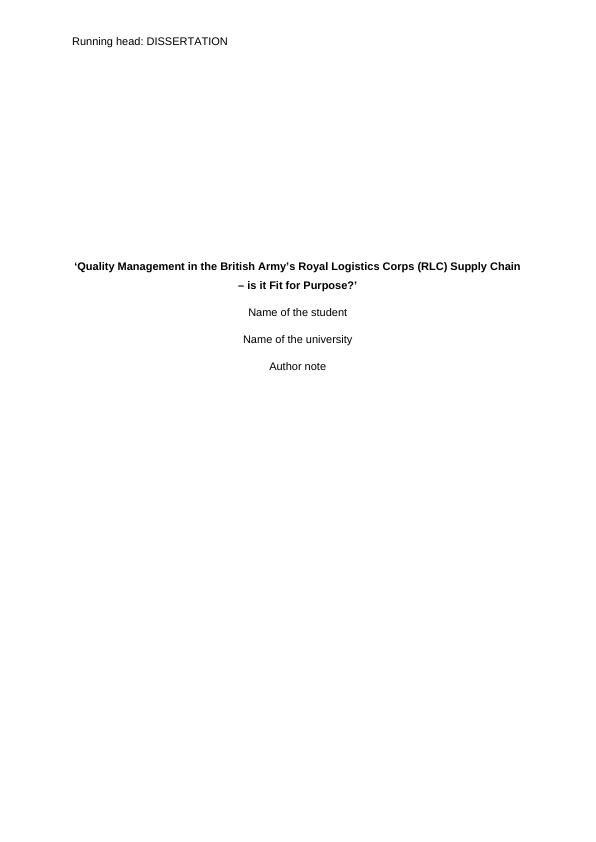
1DISSERTATION
Acknowledgements
This research has provided me the best possible in my whole life. I have been able to learn
different theories, models and concepts throughout the course of this study. I want to thank
my supervisor, ______________ who has been a friend, philosopher and guide. I also want
to take this opportunity to thank by parents for being accommodative and supportive of my
choices that I have made. I also want to thank, all my friends who provided both moral
support and knowledge to me whenever I required.
Acknowledgements
This research has provided me the best possible in my whole life. I have been able to learn
different theories, models and concepts throughout the course of this study. I want to thank
my supervisor, ______________ who has been a friend, philosopher and guide. I also want
to take this opportunity to thank by parents for being accommodative and supportive of my
choices that I have made. I also want to thank, all my friends who provided both moral
support and knowledge to me whenever I required.
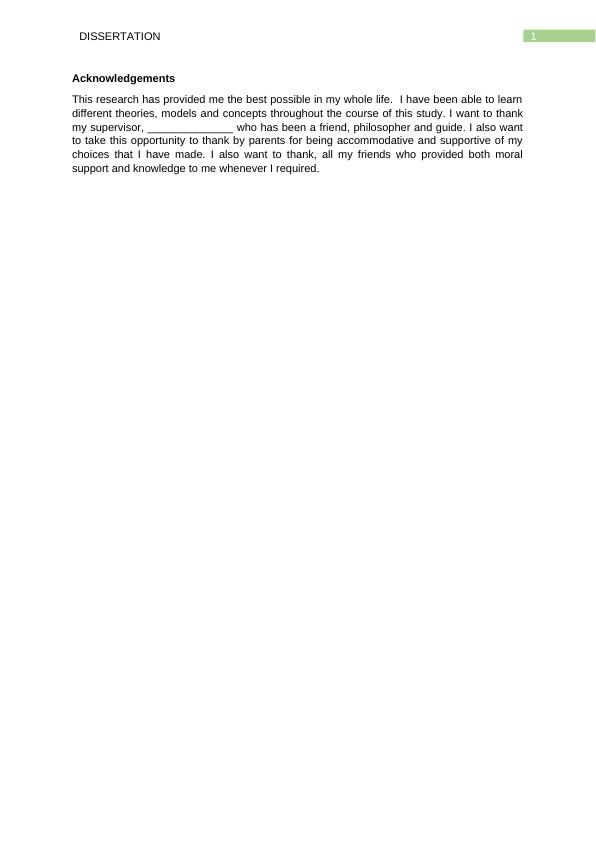
2DISSERTATION
Abstract
This research had aimed to develop a comparative analysis between Tesco PLC and Royal
Logistics Corps. The quality management practices of RLC had been evaluated and
compared with commercial business organizations. The research evaluated the difference in
management practices between both the chosen organizations and whether the supply
chain management practices are fit or not. The critical analysis of the literature had shown
that supply chain management practices and quality management is critical for developing
effective management practices in organizations. The relationship between supply chain,
quality management and supply chain quality management has been critically highlighted. In
this study, mixed method research design had been developed where pragmatist approach
had been taken. The study had used sequential explanatory as the method for analysing the
data collected. The sample size for the research is 100 for quantitative analysis and 3 for the
qualitative analysis which included 50 employees each from both the organizations and 3
managers for both the organization. The findings of the study had clearly shown that there is
significant difference in supply chain operations between Tesco Plc and RLC as the first is
more orientated towards achieving competitive advantage in the market. Moreover, it had
also been seen that RLC is not using best practices in the industry and further elaboration on
the shortcomings of the organization had been given in detail in findings, analysis and
conclusion part of the research paper.
Abstract
This research had aimed to develop a comparative analysis between Tesco PLC and Royal
Logistics Corps. The quality management practices of RLC had been evaluated and
compared with commercial business organizations. The research evaluated the difference in
management practices between both the chosen organizations and whether the supply
chain management practices are fit or not. The critical analysis of the literature had shown
that supply chain management practices and quality management is critical for developing
effective management practices in organizations. The relationship between supply chain,
quality management and supply chain quality management has been critically highlighted. In
this study, mixed method research design had been developed where pragmatist approach
had been taken. The study had used sequential explanatory as the method for analysing the
data collected. The sample size for the research is 100 for quantitative analysis and 3 for the
qualitative analysis which included 50 employees each from both the organizations and 3
managers for both the organization. The findings of the study had clearly shown that there is
significant difference in supply chain operations between Tesco Plc and RLC as the first is
more orientated towards achieving competitive advantage in the market. Moreover, it had
also been seen that RLC is not using best practices in the industry and further elaboration on
the shortcomings of the organization had been given in detail in findings, analysis and
conclusion part of the research paper.
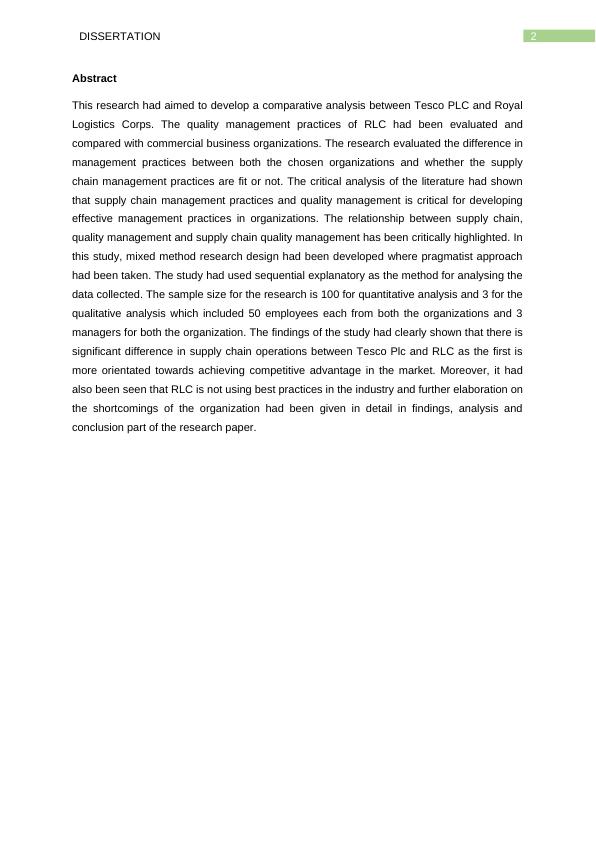
3DISSERTATION
Table of Contents
Chapter 1: Introduction.............................................................................................................5
1.0 Introduction........................................................................................................................5
1.1 Background of the study....................................................................................................5
1.2 Research Problem.............................................................................................................6
1.3 Research Aim and Objectives............................................................................................6
1.4 Research Question............................................................................................................6
1.5 Research Hypothesis.........................................................................................................6
1.6 Summary............................................................................................................................7
Chapter 2: Literature Review...................................................................................................8
2.1 Introduction........................................................................................................................8
2.2 Supply chain management.................................................................................................8
2.3 Quality Management..........................................................................................................9
2.4 Supply chain quality management.....................................................................................9
2.5 Relationship among SC, QM and SCQM.........................................................................11
2.6 Literature Gap..................................................................................................................11
2.7 Summary..........................................................................................................................11
Chapter 3: Research Methodology........................................................................................13
3.0 Introduction......................................................................................................................13
3.1 Research Philosophy.......................................................................................................13
3.2 Research Approach.........................................................................................................13
3.3 Research design..............................................................................................................14
3.4 Data collection and Analysis............................................................................................14
3.5 Sampling..........................................................................................................................15
3.6 Reliability and Validity......................................................................................................16
3.7 Ethical Consideration.......................................................................................................16
3.8 Summary..........................................................................................................................16
Chapter 4: Result...................................................................................................................17
4.1 Reliability test...................................................................................................................17
Table of Contents
Chapter 1: Introduction.............................................................................................................5
1.0 Introduction........................................................................................................................5
1.1 Background of the study....................................................................................................5
1.2 Research Problem.............................................................................................................6
1.3 Research Aim and Objectives............................................................................................6
1.4 Research Question............................................................................................................6
1.5 Research Hypothesis.........................................................................................................6
1.6 Summary............................................................................................................................7
Chapter 2: Literature Review...................................................................................................8
2.1 Introduction........................................................................................................................8
2.2 Supply chain management.................................................................................................8
2.3 Quality Management..........................................................................................................9
2.4 Supply chain quality management.....................................................................................9
2.5 Relationship among SC, QM and SCQM.........................................................................11
2.6 Literature Gap..................................................................................................................11
2.7 Summary..........................................................................................................................11
Chapter 3: Research Methodology........................................................................................13
3.0 Introduction......................................................................................................................13
3.1 Research Philosophy.......................................................................................................13
3.2 Research Approach.........................................................................................................13
3.3 Research design..............................................................................................................14
3.4 Data collection and Analysis............................................................................................14
3.5 Sampling..........................................................................................................................15
3.6 Reliability and Validity......................................................................................................16
3.7 Ethical Consideration.......................................................................................................16
3.8 Summary..........................................................................................................................16
Chapter 4: Result...................................................................................................................17
4.1 Reliability test...................................................................................................................17

4DISSERTATION
4.2 Frequency distribution......................................................................................................19
4.3 Normality test and comparison.........................................................................................51
4.4 Qualitative data................................................................................................................57
Chapter 5: Analysis................................................................................................................59
Chapter 6: Conclusions..........................................................................................................63
6.1 Conclusion.......................................................................................................................63
6.2 Recommendation.............................................................................................................64
6.3 Future Scope....................................................................................................................64
References:............................................................................................................................65
Appendices............................................................................................................................69
4.2 Frequency distribution......................................................................................................19
4.3 Normality test and comparison.........................................................................................51
4.4 Qualitative data................................................................................................................57
Chapter 5: Analysis................................................................................................................59
Chapter 6: Conclusions..........................................................................................................63
6.1 Conclusion.......................................................................................................................63
6.2 Recommendation.............................................................................................................64
6.3 Future Scope....................................................................................................................64
References:............................................................................................................................65
Appendices............................................................................................................................69

5DISSERTATION
CHAPTER 1: INTRODUCTION
1.0 INTRODUCTION
This research has aimed to examine the Quality management practices in the RLC’s
supply chain to identify whether they follow best practices in the industry. Supply Chain
Quality Management practices are critical for improving the production quality and
procedures within organizations. The research has compared the best practices in
commercial companies with British Army’s Royal Logistics Corps (RLC) Supply Chain (SC)
to examine its detrimental effect on the organizations supply chain. Tesco Plc has been
chosen as the organization for comparison as it is the market leader in the United Kingdom
retail industry and follows best practices.
1.1 BACKGROUND OF THE STUDY
Royal Logistics Corps (RLC) is responsible for providing logistic support and other
functions to the British Army. It is one of the largest corps in the army and are diverse in
nature. The corps is responsible for supporting the army’s operations by providing
ammunition, parts, tools, water and ration (Army.mod.uk 2019). RLC is responsible for the
sustainability of the troops by air, sea and land. The organization was formed in the year of
1993 on 5th April by combining five units: Army Catering Corps, Royal Army Ordnance
Corps, Royal corps of transport and Postal and courier services (Army.mod.uk 2019).
There has been significant increase in complexity on battlefield and it has become
non-linear, multidimensional, operations with high tempo, time space that is compressed,
nuclear ambiguity and high level of transparency. This means that the current requirement
for every army is to improve the effectiveness of their logistics capabilities, integrated
resource employment, integration of logistics execution and integration at national level
(Bousquet 2017). This means that the importance of quality management supply chain
practices have increased exponentially in the past decade. The incorporation of modern
technology is not sufficient to improve the sustainability of the RLC and it is essential to
understand the best practices in warehouse management and logistics so that overall cost of
the corps can be reduced (Moore 2017). Therefore, it is essential to understand the use of
logistics and warehouse management in commercial as they are continuously innovating
their processes to reduce the operational cost. Research conducted in the past decade has
focused on the development of effective supply chain practices which consists of methods
that are tried and tested. The use of adaptive innovation with adoption of the best practices
facilitates in streamlining the overall process.
CHAPTER 1: INTRODUCTION
1.0 INTRODUCTION
This research has aimed to examine the Quality management practices in the RLC’s
supply chain to identify whether they follow best practices in the industry. Supply Chain
Quality Management practices are critical for improving the production quality and
procedures within organizations. The research has compared the best practices in
commercial companies with British Army’s Royal Logistics Corps (RLC) Supply Chain (SC)
to examine its detrimental effect on the organizations supply chain. Tesco Plc has been
chosen as the organization for comparison as it is the market leader in the United Kingdom
retail industry and follows best practices.
1.1 BACKGROUND OF THE STUDY
Royal Logistics Corps (RLC) is responsible for providing logistic support and other
functions to the British Army. It is one of the largest corps in the army and are diverse in
nature. The corps is responsible for supporting the army’s operations by providing
ammunition, parts, tools, water and ration (Army.mod.uk 2019). RLC is responsible for the
sustainability of the troops by air, sea and land. The organization was formed in the year of
1993 on 5th April by combining five units: Army Catering Corps, Royal Army Ordnance
Corps, Royal corps of transport and Postal and courier services (Army.mod.uk 2019).
There has been significant increase in complexity on battlefield and it has become
non-linear, multidimensional, operations with high tempo, time space that is compressed,
nuclear ambiguity and high level of transparency. This means that the current requirement
for every army is to improve the effectiveness of their logistics capabilities, integrated
resource employment, integration of logistics execution and integration at national level
(Bousquet 2017). This means that the importance of quality management supply chain
practices have increased exponentially in the past decade. The incorporation of modern
technology is not sufficient to improve the sustainability of the RLC and it is essential to
understand the best practices in warehouse management and logistics so that overall cost of
the corps can be reduced (Moore 2017). Therefore, it is essential to understand the use of
logistics and warehouse management in commercial as they are continuously innovating
their processes to reduce the operational cost. Research conducted in the past decade has
focused on the development of effective supply chain practices which consists of methods
that are tried and tested. The use of adaptive innovation with adoption of the best practices
facilitates in streamlining the overall process.
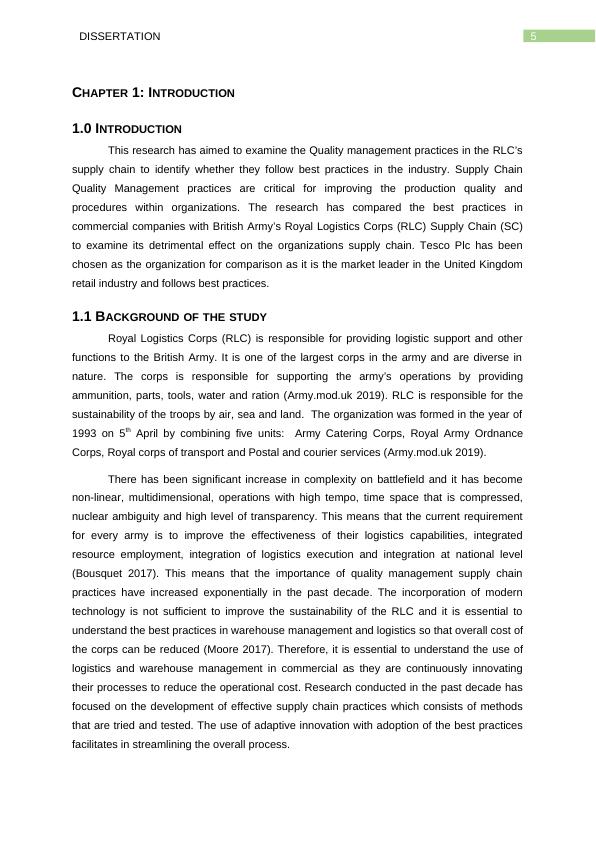
6DISSERTATION
1.2 RESEARCH PROBLEM
The application of modern warehousing and logistics is still lacking in the British
Army’s Royal Logistics Corps (RLC) Supply Chain (SC). Globalization has changed the way
modern organizations use their supply chain capabilities where there is a constant need for
improving the overall processes within the organization. Distribution and warehousing is one
of the key aspect for RLC as they need to be prepared to deploy support on a global scale.
The logistics specialist officers and other logistics personnel visited RCL logistics which is an
award winning third party provider in the Corby region to gain knowledge on the efficient
practices when operating under a commercial setting (RCS Logistics 2018). The purpose of
these event was to provide adequate knowledge to all the personnel regarding the best
supply chain practices within commercial industries. This presents doubt about the practices
within Royal Logistics Corps and the research has been conducted to address this issue.
1.3 RESEARCH AIM AND OBJECTIVES
The objectives of the following study are as follows:
To highlight and evaluate the Supply Chain Quality Management practices of the
RLC and Tesco.
To critically compare the Supply Chain Quality Management practices of the RLC
and Tesco to illustrate the difference
To determine if the Quality Management practices in the RLC’s Supply Chain follows
best practice and is fit for purpose.
To recommend suitable changes in supply chain quality management if required.
1.4 RESEARCH QUESTION
What are the Supply Chain Quality Management practices of the RLC and Tesco?
What are the difference in Supply Chain Quality Management practices of the RLC
and Tesco?
Are the Quality Management practices in the RLC’s Supply Chain follows best
practice and is fit for purpose?
1.5 RESEARCH HYPOTHESIS
H01: There is no significant difference in supply chain quality management practices in RLC
and Tesco
1.2 RESEARCH PROBLEM
The application of modern warehousing and logistics is still lacking in the British
Army’s Royal Logistics Corps (RLC) Supply Chain (SC). Globalization has changed the way
modern organizations use their supply chain capabilities where there is a constant need for
improving the overall processes within the organization. Distribution and warehousing is one
of the key aspect for RLC as they need to be prepared to deploy support on a global scale.
The logistics specialist officers and other logistics personnel visited RCL logistics which is an
award winning third party provider in the Corby region to gain knowledge on the efficient
practices when operating under a commercial setting (RCS Logistics 2018). The purpose of
these event was to provide adequate knowledge to all the personnel regarding the best
supply chain practices within commercial industries. This presents doubt about the practices
within Royal Logistics Corps and the research has been conducted to address this issue.
1.3 RESEARCH AIM AND OBJECTIVES
The objectives of the following study are as follows:
To highlight and evaluate the Supply Chain Quality Management practices of the
RLC and Tesco.
To critically compare the Supply Chain Quality Management practices of the RLC
and Tesco to illustrate the difference
To determine if the Quality Management practices in the RLC’s Supply Chain follows
best practice and is fit for purpose.
To recommend suitable changes in supply chain quality management if required.
1.4 RESEARCH QUESTION
What are the Supply Chain Quality Management practices of the RLC and Tesco?
What are the difference in Supply Chain Quality Management practices of the RLC
and Tesco?
Are the Quality Management practices in the RLC’s Supply Chain follows best
practice and is fit for purpose?
1.5 RESEARCH HYPOTHESIS
H01: There is no significant difference in supply chain quality management practices in RLC
and Tesco
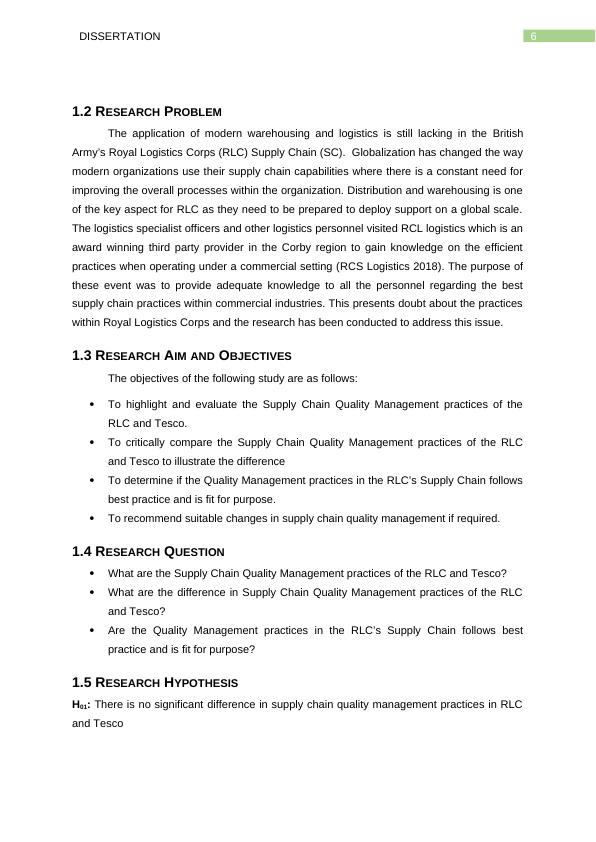
7DISSERTATION
H11: There is significant difference in supply chain quality management practices in RLC and
Tesco
H02: Quality management practices in the RLC’s supply chain is fit for purpose
H12: Quality management practices in the RLC’s supply chain is not fit for purpose
1.6 SUMMARY
This chapter as the name suggests has introduced the research topic effectively. It
has provided an understanding of the research problem and the significant contribution of
the research. The different objectives and research questions have been formulated which
determines the scope of the research. The hypothesis has been developed based on the
objective of the research and addresses all the aspect of the research.
H11: There is significant difference in supply chain quality management practices in RLC and
Tesco
H02: Quality management practices in the RLC’s supply chain is fit for purpose
H12: Quality management practices in the RLC’s supply chain is not fit for purpose
1.6 SUMMARY
This chapter as the name suggests has introduced the research topic effectively. It
has provided an understanding of the research problem and the significant contribution of
the research. The different objectives and research questions have been formulated which
determines the scope of the research. The hypothesis has been developed based on the
objective of the research and addresses all the aspect of the research.
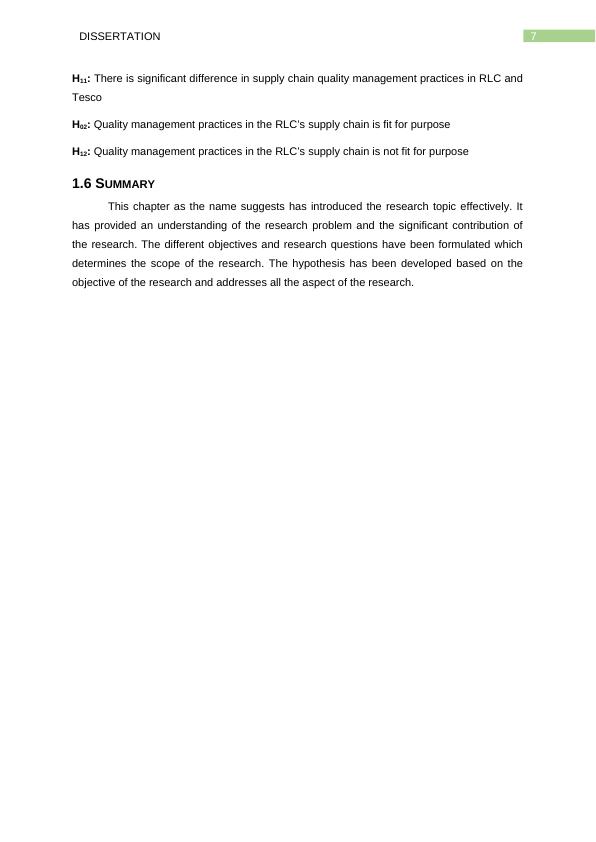
End of preview
Want to access all the pages? Upload your documents or become a member.
Related Documents
Challenges in Supply Chain and Logistics Management: A Study on DHLlg...
|36
|9396
|37
Third Party Logistic outsourcing on the performance of FMCG companylg...
|55
|18190
|45
Impact of Green Supply Chain Management on Organizational Performancelg...
|71
|18259
|463
International Logistics Assignment: Impact of BREXITlg...
|64
|21162
|58
Masters of Supply Chain Management Cab Service in Australialg...
|45
|9831
|85
The impact of the logistics management in customer satisfaction PDFlg...
|49
|10765
|83
